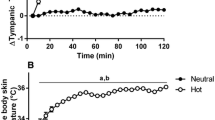Abstract
Reports of subjective experiences of 73 hypertensive patients who were treated with thermal biofeedback for hand warming were obtained over 16 treatment sessions. Most of the differential responding in subjective report occurred in the first 5 sessions. Differences in reports of throbbing were associated with medication status during treatment (presence of sympatholytic antihypertensive agent). From 4 to 9% of patients report negative subjective experiences at any one session. When short-term clinical successes (either elimination of medication or reduction of BP) were compared with short-term failures, it was found that successes reported more warmth, more likelihood of falling asleep, and more dreamlike experiences. The latter were more likely to occur suddenly for the successes. Correlational analyses revealed consistent positive associations between reports of warmth and relaxation with highest temperature achieved in the session and consistent negative associations between experiencing physical sensations and degree of temperature change within the session.
Similar content being viewed by others
References
Blanchard, E. B., & Andrasik, F. (1987). Biofeedback treatment of vascular headache. In J. P. Hatch, J. D. Rugh, & J. G. Fisher (Eds.),Biofeedback studies in clinical efficacy. New York: Plenum.
Blanchard, E. B., Khramelashvili, V. V., McCoy, G. C., Aivazyan, T. A., McCaffrey, R. J., Salenko, B. B., Musso, A., Wittrock, D. A., Berger, M., Gerardi, M. A., & Pangburn, L. (1988). The USSR-USA collaborative cross-cultural comparison of autogenic training and thermal biofeedback in the treatment of mild hypertension.Health Psychology, 7 175–192.
Blanchard, E. B., Martin, J. E., & Dubbert, P. M. (1988).Non-drug treatments for essential hypertension. Elmsford, NY: Pergamon Press.
Blanchard, E. B., McCoy, G. C., McCaffrey, R. J., Berger, M., Musso, A. J., Wittrock, D. A., Gerardi, M. A., Halpern, M., & Pangburn, L. (1987). Evaluation of a minimal-therapist-contact thermal biofeedback treatment program for essential hypertension.Biofeedback and Self-Regulation, 12 93–103.
Blanchard, E. B., McCoy, G. C., Musso, A., Gerardi, M. A., Pallmeyer, T. P., Gerardi, R. J. Cotch, P. A., Siracusa, K., & Andrasik, F. (1986). A controlled comparison of thermal biofeedback and relaxation training in the treatment of essential hypertension: I. Short-term and long-term outcome.Behavior Therapy, 17 563–579.
Fahrion, S., Norris, P., Green, A. Green, E., & Snarr, C. (1986). Biobehavioral treatment of essential hypertension: A group outcome study.Biofeedback and Self-Regulation, 11 257–278.
Green, E. E., Green, A. N., & Norris, P. A. (1979). Preliminary observations on the new non-drug method for control of hypertension.Journal of the South Carolina Medical Association, 75 575–586.
Heide, F. J., & Borkovec, T. D. (1983). Relaxation-induced anxiety: Paradoxical anxiety enhancement due to relaxation training.Journal of Consulting and Clinical Psychology, 51 171–182.
McGrady, A., & Higgins, J. T. (1989). Prediction of response to biofeedback-assisted relaxation in hypertensives: Development of a hypertensive predictor profile (HYPP).Psychosomatic Medicine, 51 1–8.
Surwit, R. S., & Jordan, J. S. (1987). Behavioral treatment of Raynaud's syndrome. In J. P. Hatch, J. D. Ruch, & J. G. Fisher (Eds.),Biofeedback studies in clinical efficacy. New York: Plenum.
Wittrock, D. A., Blanchard, E. B., & McCoy, G. C. (1988). Three studies on the relation of process to outcome in the treatment of essential hypertension with relaxation and thermal biofeedback.Behaviour Research and Therapy, 26 53–66.
Author information
Authors and Affiliations
Additional information
This research was supported in part by grants from NHLBI, HL-27622 and HL-31189.
Rights and permissions
About this article
Cite this article
Blanchard, E.B., Cornish, P.J., Wittrock, D.A. et al. Subjective experiences associated with thermal biofeedback treatment of hypertension. Biofeedback and Self-Regulation 15, 145–159 (1990). https://doi.org/10.1007/BF00999145
Issue Date:
DOI: https://doi.org/10.1007/BF00999145




